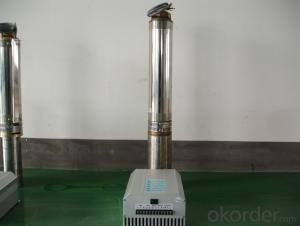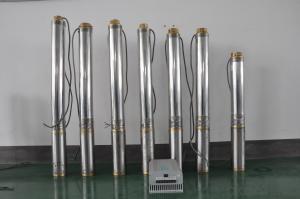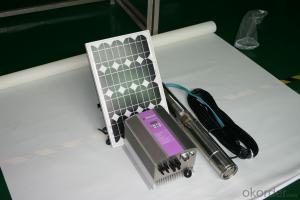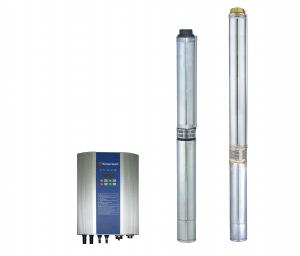DC Submersible Pump
- Loading Port:
- China Main Port
- Payment Terms:
- TT OR LC
- Min Order Qty:
- -
- Supply Capability:
- -
OKorder Service Pledge
OKorder Financial Service
You Might Also Like
Item Description :
This superb new addition to our solar fountain range comes with a 10w solar panel,and a powerful fountain pump that is capable of producing fountains of up to 2m in height. As well as being easy to set up and use.Instruction manual is supplied for assembly and maintenance.
Solar Fountain Key Features :
Powered by direct sunlight
No high voltage electric mains required
Safe for children
Max. height of fountain: 2M
Max. flow capacity: 800 L/H(176 GAL)
10W Polycrystalline solar panel included
18V DC brushless pump
Solar Pump Features :
Can produce fountains up to : 2M (tube height) 1.4M (fountain height)
Comes with multiple nozzle accessories
Cable Length : 5M
Solar Panel Features :
10W peak power.
Polycrystalline highly efficient solar panel
Comes mounted in aluminium frame
Comes with ground stake and rotating knob so you can angle your panel toward the sun
What You Will Get :
10W solar panel
Solar pump
Ground Sake
Nozzle accessories
Precautions :
DO NOT alter or change the product itself or its components
Operate pump in freshwater only, never above 50 degrees celsius
Keep away from flammable liquids
Do not connect to any other power supply other than the included
- Q:Can a solar pump be used in combination with a drip irrigation system?
- A solar pump is capable of being utilized alongside a drip irrigation system. In reality, opting for a solar pump can prove to be an economical and energy-conserving choice when it comes to powering a drip irrigation system. Solar pumps operate by converting sunlight into electricity through photovoltaic panels, which is then utilized to power the pump. This eradicates the necessity for grid electricity or generators that rely on fuel, thus making it a sustainable and environmentally-friendly option. Drip irrigation systems are specifically designed to supply water directly to plant roots at a slow and regulated pace, thereby minimizing water wastage and evaporation. By combining a solar pump with a drip irrigation system, farmers and gardeners can ensure proper water distribution to crops at the appropriate time, while simultaneously reducing water consumption and optimizing plant growth. Solar pumps can be adjusted to meet the precise water requirements of a drip irrigation system, allowing for accurate control over water flow and delivery. Additionally, they can be equipped with sensors and controllers to automate the irrigation process, further enhancing efficiency and reducing manual labor. Moreover, utilizing a solar pump for drip irrigation can prove to be particularly advantageous in regions with limited or unreliable access to electricity. The sun is an abundant and cost-free source of energy, rendering solar pumps a feasible solution for remote or off-grid locations. In conclusion, a solar pump unquestionably has the potential to be utilized in conjunction with a drip irrigation system, offering a sustainable, cost-effective, and efficient means of watering crops and plants.
- Q:Is it possible to retrofit an existing pump system with solar power?
- Yes, it is possible to retrofit an existing pump system with solar power. Retrofitting involves integrating solar panels and a solar power converter into the existing system. The solar panels would be installed in a location where they receive maximum sunlight exposure, typically on the roof or nearby area. The solar power converter is then connected to the existing pump system, allowing it to draw power from the solar panels. This setup enables the pump system to operate independently of the electrical grid, reducing or even eliminating the need for conventional electricity. Retrofitting with solar power offers several advantages, including lower operating costs, reduced carbon emissions, and increased energy independence. However, it is important to consider the specific requirements of the pump system and ensure that the solar power capacity is sufficient to meet the system's needs.
- Q:What is the cost of installing a solar pump?
- The cost of installing a solar pump can vary widely depending on various factors such as the size and capacity of the pump, the complexity of the installation, and the location. On average, however, the cost can range from a few thousand dollars to tens of thousands of dollars. It is recommended to consult with a solar pump installer or supplier to get an accurate estimate based on your specific needs and circumstances.
- Q:Can a solar pump system be integrated with a smart home or automation system?
- Yes, a solar pump system can indeed be integrated with a smart home or automation system. The integration of these technologies allows for increased efficiency, convenience, and control over the solar pump system. By connecting the solar pump system to a smart home or automation system, users can remotely monitor and control the operation of the pump. This can be done through a smartphone application or a central control panel within the smart home system. Users can easily adjust the pump's settings, such as flow rate and timing, from anywhere with an internet connection. Moreover, the integration with a smart home or automation system enables the solar pump system to be synchronized with other devices and systems within the house. For example, the pump can be programmed to automatically turn on and off based on temperature or humidity levels, or it can be linked to a rainwater harvesting system to ensure efficient water usage. Additionally, integrating a solar pump system with a smart home or automation system allows for data monitoring and analysis. Real-time data, such as solar irradiance levels, water flow rate, and energy consumption, can be collected and analyzed to optimize the performance of the pump system. This information can be used to identify potential issues, track energy savings, and make informed decisions regarding maintenance or upgrades. In summary, integrating a solar pump system with a smart home or automation system offers numerous benefits, including remote control, synchronization with other devices, and data monitoring. This integration allows for a more efficient and convenient operation of the solar pump system, enhancing overall energy efficiency and sustainability in the smart home or automation setup.
- Q:Can a solar pump be used in areas with limited access to water supply networks?
- Yes, a solar pump can be used in areas with limited access to water supply networks. Solar pumps do not rely on a connection to the electrical grid or existing water supply infrastructure. They can be installed in remote locations where traditional water supply networks are unavailable or inadequate. Solar pumps utilize solar energy to power the pumping mechanism, making them an ideal solution for areas with limited access to water supply networks.
- Q:Can a solar pump be used in areas with high humidity?
- Yes, a solar pump can be used in areas with high humidity. The high humidity levels do not affect the functionality or efficiency of the solar pump.
- Q:Are there any regulations on the disposal of solar pump components?
- The disposal of solar pump components is regulated by various environmental regulations and guidelines to ensure proper handling and minimize the impact on the environment. In the United States, for example, the Environmental Protection Agency (EPA) oversees the disposal of electronic waste, which includes solar pump components. The EPA has established specific guidelines and regulations to prevent the release of hazardous materials into the environment. In addition to federal regulations, many states and local governments have their own regulations on the disposal of electronic waste, including solar pump components. These regulations require individuals and businesses to recycle or dispose of electronic waste through approved channels, such as licensed recycling facilities or collection events. It is important to note that solar pump components may contain hazardous materials, such as lead, cadmium, or mercury. These materials can be harmful to human health and the environment if not disposed of properly. Therefore, it is crucial to follow the regulations and guidelines set forth by the relevant authorities to ensure the safe and environmentally friendly disposal of these components. To determine the specific regulations applicable to the disposal of solar pump components in a particular area, it is recommended to consult with local environmental agencies, waste management authorities, or recycling facilities. These entities can provide accurate and up-to-date information on the proper disposal methods and any specific regulations that must be followed.
- Q:Can a solar pump be used for water supply in disaster-affected areas?
- Yes, a solar pump can be used for water supply in disaster-affected areas. Solar pumps are a reliable and sustainable solution as they are not dependent on electricity grids that may be disrupted during disasters. They can provide a consistent water supply by harnessing solar energy, which is abundant in most disaster-affected regions. Furthermore, solar pumps are easy to install and maintain, making them suitable for emergency response efforts in such areas.
- Q:Are there any safety considerations when using a solar pump?
- Yes, there are several safety considerations when using a solar pump. Firstly, it is important to ensure that the pump and its components are installed and maintained properly by following the manufacturer's instructions. This includes proper grounding and electrical connections to avoid any electrical hazards. Secondly, as solar pumps are often used for water pumping, it is crucial to ensure that the water source is clean and free from contaminants to avoid any health risks. Additionally, users should be cautious when handling and maintaining the solar panels to prevent any damage or electrical shocks. Finally, it is essential to regularly inspect the system for any signs of wear, damage, or malfunction, and to address any issues promptly to maintain safe and efficient operation.
- Q:How does the size of the pump motor affect the performance of a solar pump?
- Determining the performance of a solar pump heavily relies on the size of the pump motor. The flow rate, pressure, and overall efficiency of the pump are directly influenced by the motor size. When the pump motor is larger, it enables a higher flow rate, resulting in the ability to pump more water within a given time period. This is particularly important in scenarios where a substantial amount of water needs to be transported, such as in agricultural irrigation or large-scale water supply systems. A higher flow rate guarantees the effective and efficient delivery of the desired volume of water. Moreover, the size of the pump motor impacts the pump's ability to generate pressure. A larger motor is capable of creating higher pressure, which becomes necessary when pumping water to elevated areas or overcoming resistance in an extensive pipe network. The increased pressure ensures that water reaches its intended destination with sufficient force and can be evenly distributed across the irrigation system or other applications. Furthermore, a larger motor often leads to improved efficiency. With a more powerful motor, the pump requires less time to complete its pumping cycle, resulting in reduced energy consumption. This not only saves costs but also promotes a more sustainable utilization of solar energy. It is important to note that while a larger motor generally offers better performance, it also demands more energy to operate. Therefore, it is crucial to find a balance between motor size and energy availability. If the solar array providing power to the pump cannot generate enough electricity to operate a larger motor, it may be necessary to opt for a smaller motor that can still meet the required performance levels without exceeding the available energy supply. To conclude, the size of the pump motor significantly impacts the performance of a solar pump. A larger motor allows for higher flow rates, increased pressure, and improved efficiency. However, it is essential to consider the available energy supply when selecting the motor size to ensure optimal performance and energy utilization.
1. Manufacturer Overview |
|
|---|---|
| Location | |
| Year Established | |
| Annual Output Value | |
| Main Markets | |
| Company Certifications | |
2. Manufacturer Certificates |
|
|---|---|
| a) Certification Name | |
| Range | |
| Reference | |
| Validity Period | |
3. Manufacturer Capability |
|
|---|---|
| a)Trade Capacity | |
| Nearest Port | |
| Export Percentage | |
| No.of Employees in Trade Department | |
| Language Spoken: | |
| b)Factory Information | |
| Factory Size: | |
| No. of Production Lines | |
| Contract Manufacturing | |
| Product Price Range | |
Send your message to us
DC Submersible Pump
- Loading Port:
- China Main Port
- Payment Terms:
- TT OR LC
- Min Order Qty:
- -
- Supply Capability:
- -
OKorder Service Pledge
OKorder Financial Service
Similar products
New products
Hot products
Related keywords




























